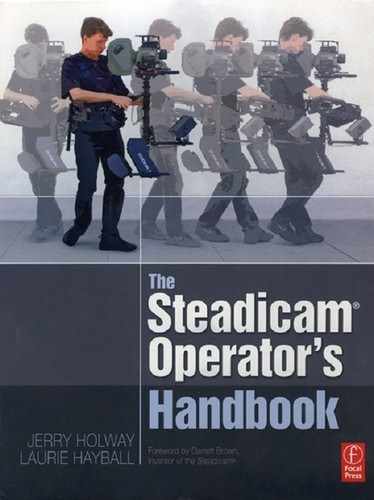Longer lenses
The Steadicam is not just for running around with wide-angle lenses. In 35 mm, we typically shoot with 35 to 75mm lenses, just like our counterparts on the dolly. Some of the most beautiful shots are done with normal to moderate telephoto lenses (50 to 150mm).

Steadicam operators use longer lenses for all the same reasons conventional camera operators use them: to make faces look better, to isolate the subject from the background, to reduce spatial clues, etc. Images become more graphic and flat, less naturalistic, more abstract, out of everyday experience. Subject to camera distance increases; things are less intimate or “in your face.”
One example
On Donnie Brasco, we used long lenses on several close tracking shots in the King's Court sequence. I like one shot of Johnny Depp in particular, done on a 75 mm. In frame one he's not moving and he's close to a matching size to the previous shot of him. As he walks toward camera, we let him grow (even though the camera is backing up) and cross frame and then let him settle into the final, close framing.
Typically, such a moving shot would be done on a wider lens to show the space and Depps move through it, but Mike Newell (the director) chose to use a long lens. With this lens choke, I think he emphasized the emotional connection between the characters, rather than their exact physical relationship (which is revealed a couple of shots later). We must watch Donnie Brasco's face: he's torn between being deceptive (as an FBI agent setting up a sting) and being an empathetic friend to Lefty.
Donnie Brasco 0:54:42

Some telephoto lenses need two Steadicams.
Both the Steadicam and a dolly would have been able to get the shot, so why did we do this shot (and the whole sequence) on the Steadicam? Certainly the shots would have cut, Steadicam to dolly and back. I think there's a more human intimacy in a Steadicam move and less emotional distance than a typical dolly shot, but the acting would get through to the audience regardless of the camera support system. Perhaps Newell wanted a consistency of attitude toward the subject by the camera operator and he liked the way the Steadicam could easily respond to varying performances by the actors. See page 228 for a description of another shot in this sequence.
We talk about altering compositions in this shot on page 135.

In Dreams 0:31:00
Another long lens shot I like is from In Dreams. In spite of the strong objections of my focus puller, Marc Hirshfeld, we did this shot with a 75 mm lens at absolute minimum focus, wide open. He was, of course, spot on with the focus, and the floor was covered with tape marks for my ideal path, distances, actor's marks, everything.
Why did we use the Steadicam? Again, there's that human quality to the Steadicam shot, the intimate connection between camera and subject, even on a 75 mm. I also felt that a dolly could not speed up and slow down to keep Clair's (Annette Benning's) face clear of the bottles. A dolly's consistent speed would have emphasized the bottles crossing her face; a cool shot but not right for the moment.
At the end of the shot, the camera moves quickly across Robert Downey Jr.'s neck, and then arcs 75 degrees around the couple and locks off as their lips touch. This simply could not have been done on the dolly.
Operating well with a long lens
When you start using longer lenses, everything is magnified, including any unwanted camera movement. The longer the lens, the more careful you need to be when balancing the sled for the shot. A motorized stage is a life-saver with longer lenses, almost a necessity. The motorized stage allows you to micro-balance the sled during the shot without moving your hands.
You also need to be extremely precise with your balance, footwork, and hand grips. The most minute corrections for imbalance start showing up on the screen very quickly. Keep that “dance tension” under control. Practice all the line dances using extreme telephoto lenses. Practice with the rig both in balance and with the rig out of balance. Note the difference it makes in your operating. Practice balancing.
Most operators increase the inertia of their rigs when using longer lenses. Try spreading out the masses of your sled as much as possible. Don't forget to extend the telescoping center post. The idea is to make your sled as resistant to angular change as you can. Consider adding a few extra pounds to the battery and the monitor, or if you have them, add Antlers™ or gyros. The longer the lens, the more help you need.
Step by step: long lens shot
- Balance the sled for the shot.
- Operate in perfect form; there's no room for error here.
- Increase the sled's inertia: spread the masses and/or add inertia.
- Use a stiffening system to eliminate shake.
- Micro-balance with the motorized stage.
Longer lenses magnify vibrations. If you've extended any part of your rig, it will vibrate more. Use the stiffening system to pre-tension your sled to reduce vibrations (see page 247). If you don't have such a system built into your sled, create one.
Many camera mounting stages are not stiff enough to use heavy telephoto lenses. Run the Vectran™ line to some part of the camera or dovetail plate to pretension the stage and reduce its vibrations. Note that you can't adjust the camera mounting stage very much when it is pre-tensioned.
